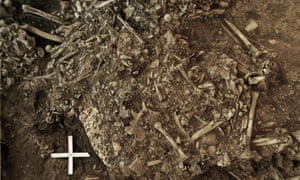via the Guardian by Ian Sample Science editor

The oldest strain of the plague was found in the teeth of a 20-year-old woman, whose remains were among those of 78 people buried in a passage grave in Gökhem, western Sweden. Photograph: Cell Press
An ancient strain of the plague found in a woman buried in Sweden may be the fatal signature of a devastating pandemic that swept through stone age farmers and set the stage for a massive migration into Europe from the east.
Evidence for the grim scenario came to light when scientists ran genetic tests on a 20-year-old woman from a rural farming community who was among 78 people buried in a passage grave in Gökhem in western Sweden.
Continue reading
==============================
via the OUP blog by Shawn Vancour

Radio by Vande Walle Ewoud. CC BY 2.0 via Flickr.
What did early US radio sound like? During radio’s initial rise to prominence in the 1920s, before the “golden age” of network broadcasting in the 1930s and 1940s, what kinds of programming, production practices, and performance styles greeted audiences’ ears when they tuned into this new medium? What strategies of musical instrumentation, sound mixing, and dramatic representation were favored for these broadcasts, and what styles of singing, playing, speaking, and acting did early radio listeners hear?
Continue reading
==============================
We aren't lunarly exclusive. Earth has a few minimoons whizzing around us, including one that comes back into our orbit every 20 years or so.
via the \Big Think blog by Mike Colagrossi
For nearly four billion years, Earth and the Moon have been inseparable as they’ve journeyed together through the cosmic void. It’s our only permanent satellite we’ll ever know. But new research has unearthed (...unmooned?) evidence that our planet occasionally captures “mini-moons” every once in a while. These tiny asteroids zoom around our planet as temporary natural satellites.
Continue reading
==============================
via Interesting Literature
A poem about growing old, but written when Alfred, Lord Tennyson (1809-92) was a young man in his early twenties, ‘Ulysses’ has been analysed as a response to the death of Tennyson’s close friend, Arthur Henry Hallam.
Continue reading
==============================
via Boing Boing by Andrea James
The Miniglobelet series by Beauty of Science shows all the wondrous math and physics occuring at the micrscopic level as crystals form, chemicals combine, and new forms take shape.
There’s more where that came from!
==============================
via About History by Alcibiades

The population of the annexed lands, with the exception of the Danish-speaking inhabitants of northern Schleswig, loyally perceived the annexation of Prussia by their states. Deprived of their possessions, the monarchs received rich incomes as compensation, unless they tried to fight for the restoration. On retaining the independence of the small monarchs of northern Germany, Prussia pressed to create a military-political North German union.
Continue reading
==============================
via the OUP blog

‘Lion cubs on the Masai Mara’ by Christopher Michel. CC BY 2.0 via Wikimedia Commons
Lions have enchanted humans since early Antiquity, and were even represented in European cave paintings from 35,000 years ago. They are regularly the main characters in folklore and allegory, appearing everywhere from African folktales to the Bible. It is not hard to see why lions are so ubiquitously revered. Their fearsome yet stunning appearance, combined with their endearing hunting tactics and formidable roar, answers any questions as to why early societies named the lion ‘King of the Beasts’, and indeed explains why this name is still used today. Lions have pervaded a plethora of aspects of today’s society, regularly featuring in films and documentaries, appearing as statues, and having English pubs named after them.
Continue reading
How cute are these?
==============================
via the Big Think blog by Mike Colagrossi
The Medici family had a long and powerful influence in European history for hundreds of years. They were well known for their banking prowess and are synonymous as an unparalleled patron of the arts during the Italian Renaissance.
Continue reading
==============================
via Boing Boing by Andrea James

Steve Moriarty of MoreGems.com works with designer Christopher Michael to create beautiful faceted gemstones, like this hyalite opal that glows under UV light.
Continue reading
==============================
via Interesting Literature
‘Surprised by joy—impatient as the Wind’ is the first line of one of William Wordsworth’s most popular sonnets. However, the degree to which ‘Surprised by joy’ can be considered a truly great and successful poem is disputed by critics, so a few words of analysis may help to ascertain how far Wordsworth’s poem succeeds and how far it falls short of the greatness we expect from one of Romanticism’s most popular and enduring poetic voices.
Continue reading
No comments:
Post a Comment